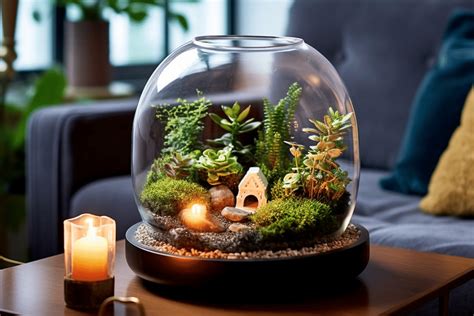Introduction
Terrariums are self-contained ecosystems that create a miniature world for plants. Tropical terrariums, in particular, offer a captivating habitat for exotic flora that thrive in warm, humid environments. However, providing adequate lighting is crucial for these plants to flourish and maintain their natural beauty.

Understanding Tropical Plant Lighting Needs
Tropical plants have evolved under lush canopies, receiving a diffused and shaded light exposure. Hence, it’s essential to replicate these conditions within a terrarium. As a general rule:
- Light Intensity: Tropical plants prefer moderate to high light intensity, ranging from 1000 to 5000 lux.
- Light Duration: Most species require 12-14 hours of light per day to thrive.
- Light Spectrum: Tropical plants respond best to a combination of red, blue, and green wavelengths.
Choosing the Right Light Source
Various light sources can be utilized for tropical terrariums, each with its advantages and disadvantages:
| Type of Light Source | Pros | Cons |
|---|---|---|
| Fluorescent Bulbs | Energy-efficient, full-spectrum options | Can be bulky and emit heat |
| Compact Fluorescent Lamps (CFLs) | Energy-efficient, compact, and available in various spectrums | Lower light output than fluorescent bulbs |
| High-Intensity Discharge (HID) Lamps | High light output, long lifespan | Energy-intensive, expensive |
| LED Grow Lights | Energy-efficient, customizable spectrum, less heat emission | Can be more expensive than other options |
Proper Light Placement
Positioning the light source correctly is essential to ensure even light distribution. Here are some guidelines:
- Distance from Plants: Keep the light source 6-12 inches above the tallest plant.
- Light Diffuser: Use a shade or diffuser to prevent direct sunlight from burning the foliage.
- Adjustable Height: Opt for light fixtures that allow height adjustment to accommodate plant growth.
Additional Considerations
Apart from providing adequate light, consider these factors to optimize plant health and growth:
- Air Circulation: Ensure proper ventilation to prevent stagnant air and humidity build-up.
- Fertilization: Fertilize plants regularly with a balanced formula to supplement nutrient supply.
- Substrate: Use a well-draining substrate that provides adequate moisture retention.
Lighting Tropical Terrariums: A Step-by-Step Guide
Follow these steps to set up optimal lighting for your tropical terrarium:
- Determine Plant Lighting Needs: Research the specific light requirements of your plant species.
- Choose Light Source: Select a light source that meets the intensity, duration, and spectrum requirements.
- Install Light Fixture: Position the light fixture according to the distance and height guidelines.
- Light Diffuser: Use a diffuser if necessary to prevent direct sunlight from damaging the plants.
- Monitor Plant Growth: Observe plant health and adjust the lighting intensity or duration as needed.
Troubleshooting Common Lighting Issues
- Yellowing Leaves: Inadequate light intensity or poor light distribution.
- Stunted Growth: Too little light or improper light spectrum.
- Leaf Burn: Too much light or direct sunlight exposure.
- Edema: Overwatering or excessive humidity combined with inadequate light.
Conclusion
Providing optimal lighting is essential for the health and aesthetics of tropical terrarium plants. By understanding their specific needs, choosing the right light source, and implementing proper placement techniques, you can create a thriving miniature ecosystem that mimics their natural habitat.
Call to Action:
Visit our online store today to browse our selection of high-quality lighting solutions for tropical terrariums. Let your plants flourish under the perfect light!
FAQs
Q: Can I use natural sunlight for my tropical terrarium?
A: Yes, but provide filtered sunlight to avoid direct burning of the foliage.
Q: How often should I replace my terrarium light bulbs?
A: Fluorescent bulbs typically last 8,000-10,000 hours, while LEDs can last up to 50,000 hours.
Q: What is the difference between full-spectrum and non-full-spectrum lights?
A: Full-spectrum lights emit all colors of the visible spectrum, providing a more natural light environment for plants.
Q: Can I use terrarium lighting to support photosynthesis?
A: Yes, terrarium lighting can provide the necessary energy for photosynthesis, aiding in plant growth and health.
Reviews
5-Star Review:
“This LED grow light is an excellent investment for my tropical terrarium. My plants have never looked so vibrant and healthy!”
4-Star Review:
“The fluorescent bulb provides adequate light, but it can get quite hot. I recommend using a diffuser to prevent heat damage.”
3-Star Review:
“The CFL bulb is compact and energy-efficient, but the light output is a bit weak for larger terrariums.”
2-Star Review:
“The HID lamp emits a lot of heat and can be difficult to maintain. I would not recommend it for beginners.”





















